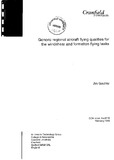- CERES Home
- →
- School of Engineering (SoE)
- →
- CoA. Reports
- →
- View Item
JavaScript is disabled for your browser. Some features of this site may not work without it.
| dc.contributor.author | Gautrey, Jim | en_UK |
| dc.date | 1998 | en_UK |
| dc.date.accessioned | 2005-11-23T12:21:05Z | |
| dc.date.available | 2005-11-23T12:21:05Z | |
| dc.date.issued | 1998 | en_UK |
| dc.identifier.uri | http://hdl.handle.net/1826/218 | |
| dc.description.abstract | This report describes a series of flying qualities investigations designed to look at flying qualities issues associated with fly-by-wire control laws for civil transport aircraft. It follows on from a previous study which considered flying qualities for the reconfiguration, approach and landing tasks. Issues raised during this previous study were followed up and design improvements made to the control laws in order t o improve them for this subsequent series of evaluations. Two different tasks are considered for this series of evaluations for the following reasons. Firstly, the control laws were only evaluated between airspeeds of 140 knots and 121 knots for the approach and then to approximately 115 knots in the flare during the previous set of evaluations. This obviously does not cover the entire aircraft airspeed range, but since the approach and landing task is generally accepted t o be the most critical task for a civil aircraft, it is deemed a suitable task for evaluating the control laws under consideration. However, civil aircraft manufacturers generally use other tasks for the evaluation of control laws since there is a requirement t o test the laws over the full flight envelope. For example, several different tasks were used for evaluation during the design of the Boeing 777, including a variety of approach tasks, en-route tasks, and in-flight tracking type tasks. A formation flying task was therefore proposed as a suitable task for evaluating control law performance at altitude for the generic regional aircraft. It was initially thought t o be a tight flight path control task, and this was quickly confirmed from a brief trial prior t o the main evaluations. In addition, this task is one which is the most demanding for a large military aircraft since it requires precision control of both flight path and airspeed. Finally, it is becoming more and more common to use modified civil aircraft in either the military transport or in-flight refuelling roles, with the Vickers VC-10 and Lockheed L-1101 being used as in-flight refuelling receivers and tankers and the Nimrod (Military Comet) as a receiver in the Royal Air Force alone. It was also decided t o consider atmospheric effects. Initially, it was proposed t o consider the effects of both windshear and turbulence, but evaluations in turbulent conditions were later dropped since its main effect is in the longitudinal (airspeed) axis, with effects in the longitudinal (pitch) axis being limited by the effects of the control laws. In addition it did not give repeatable results. However windshear, which here is taken to represent a decreasing headwind, is a flight path control problem since it causes an effective change in aircraft flight path angle, and it was found to be a much more suitable task. | en_UK |
| dc.description.sponsorship | The University | en_UK |
| dc.format.extent | 1963 bytes | |
| dc.format.extent | 2311957 bytes | |
| dc.format.mimetype | text/plain | |
| dc.format.mimetype | application/pdf | |
| dc.language.iso | en_UK | en_UK |
| dc.relation.ispartofseries | College of Aeronautics Report;9710 | en_UK |
| dc.relation.ispartofseries | CU/CoA/R;9710 | en_UK |
| dc.title | Generic regional aircraft flying qualities for the windshear and formation flying tasks | en_UK |
| dc.type | Technical Report | en_UK |
Files in this item
This item appears in the following Collection(s)
-
CoA. Reports [280]

